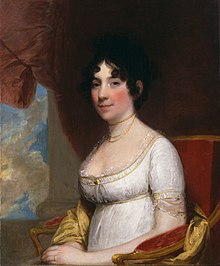Dolley Madison
| Dolley Madison | |
|---|---|
 |
|
| First Lady of the United States | |
|
In role March 4, 1809 – March 4, 1817 |
|
| President | James Madison |
| Preceded by | Martha Randolph (Acting) |
| Succeeded by | Elizabeth Monroe |
| Personal details | |
| Born |
Dolley Payne May 20, 1768 Guilford County, North Carolina, British America |
| Died | July 12, 1849 (aged 81) Washington, D.C., U.S. |
| Spouse(s) | John Todd (1790–1793) James Madison (1794–1836) |
| Children |
John William |
| Religion | Quaker |
| Signature | |
 |
|
|
|
Dolley Payne Todd Madison (May 20, 1768 – July 12, 1849) was the wife of James Madison, President of the United States from 1809 to 1817. She was noted for her social graces, which boosted her husband’s popularity as President. In this way, she did much to define the role of the President’s spouse, known only much later by the title First Lady—a function she had sometimes performed earlier for the widowed Thomas Jefferson.
Dolley Madison also helped to furnish the newly constructed White House. When the British set fire to it in 1814, she was credited with saving the classic portrait of George Washington. In widowhood, she often lived in poverty, partially relieved by the sale of her late husband’s papers.
The first girl in her family, Dolley Payne was born on May 20, 1768, in the Quaker settlement of New Garden, North Carolina, in Guilford County to Mary Coles Payne and John Payne Jr, both Virginians who had moved to North Carolina in 1765. Mary Coles, a Quaker, had married John Payne, a non-Quaker, in 1761. Three years later, he applied and was admitted to the Quaker Monthly Meeting in Hanover County, Virginia, where Coles' parents lived, and they reared their children in the Quaker faith.
By 1769, the Paynes had returned to Virginia, and young Dolley grew up in comfort at her parents' plantation in rural eastern Virginia and became deeply attached to her mother's family. Eventually she had three sisters: Lucy, Anna, and Mary; and four brothers: Walter, William Temple, Isaac, and John.
In 1783, following the American Revolutionary War, John Payne emancipated his slaves, as did numerous slaveholders in the Upper South. Some, like Payne, were Quakers, who had long encouraged manumission; others were inspired by revolutionary ideals. From 1782 to 1810, the proportion of free blacks to the total black population in Virginia increased from less than one percent to 7.2 percent, and more than 30,000 blacks were free.
...
Wikipedia
